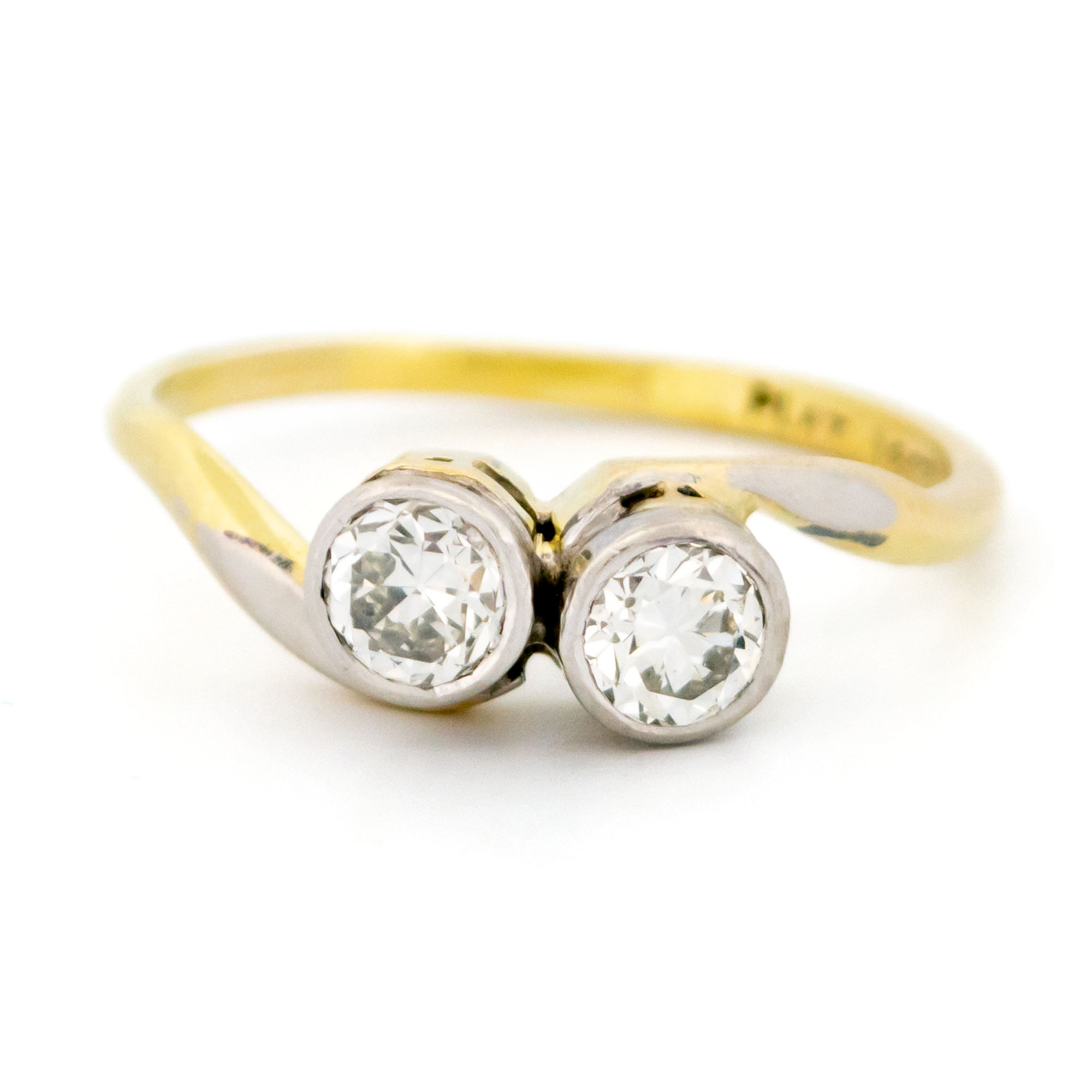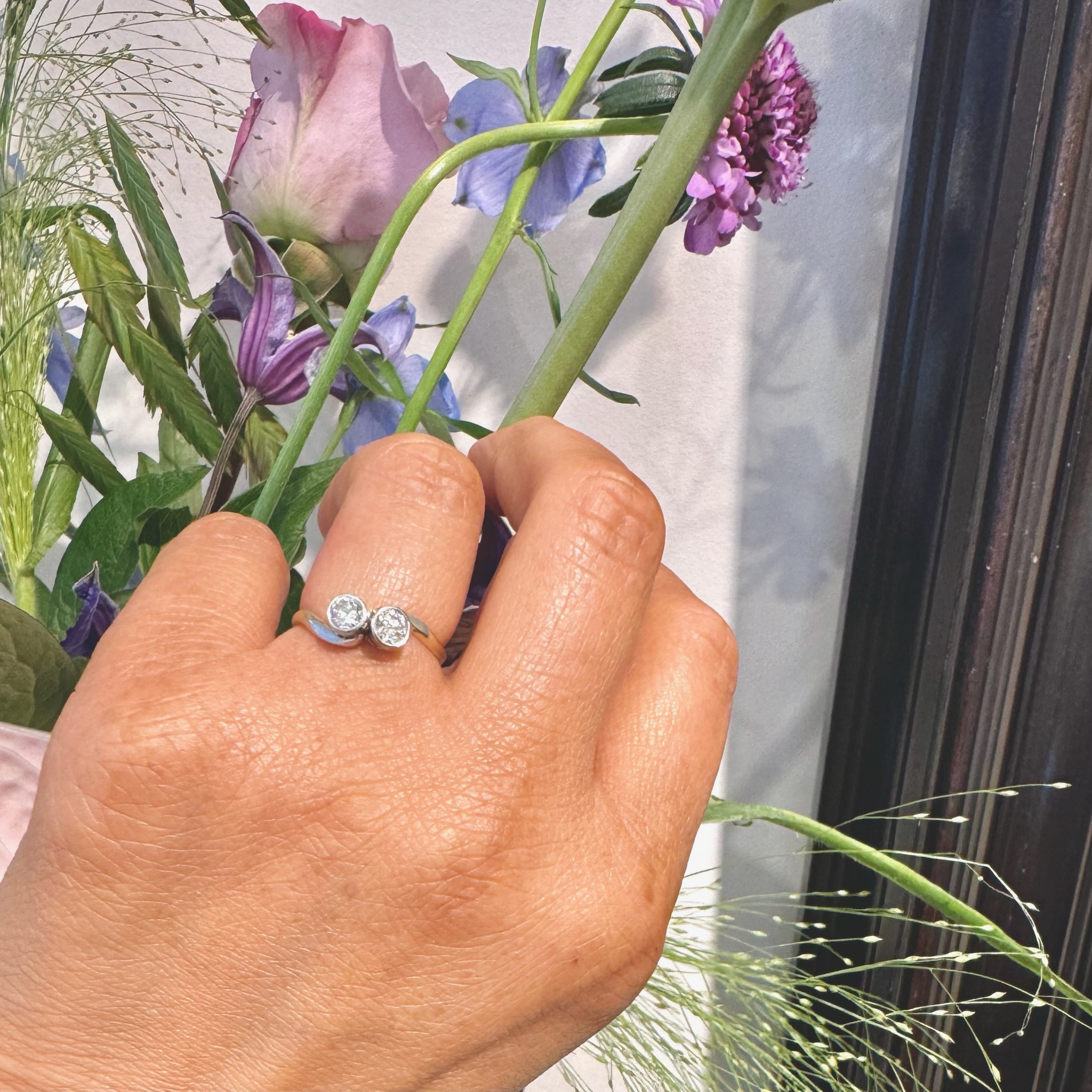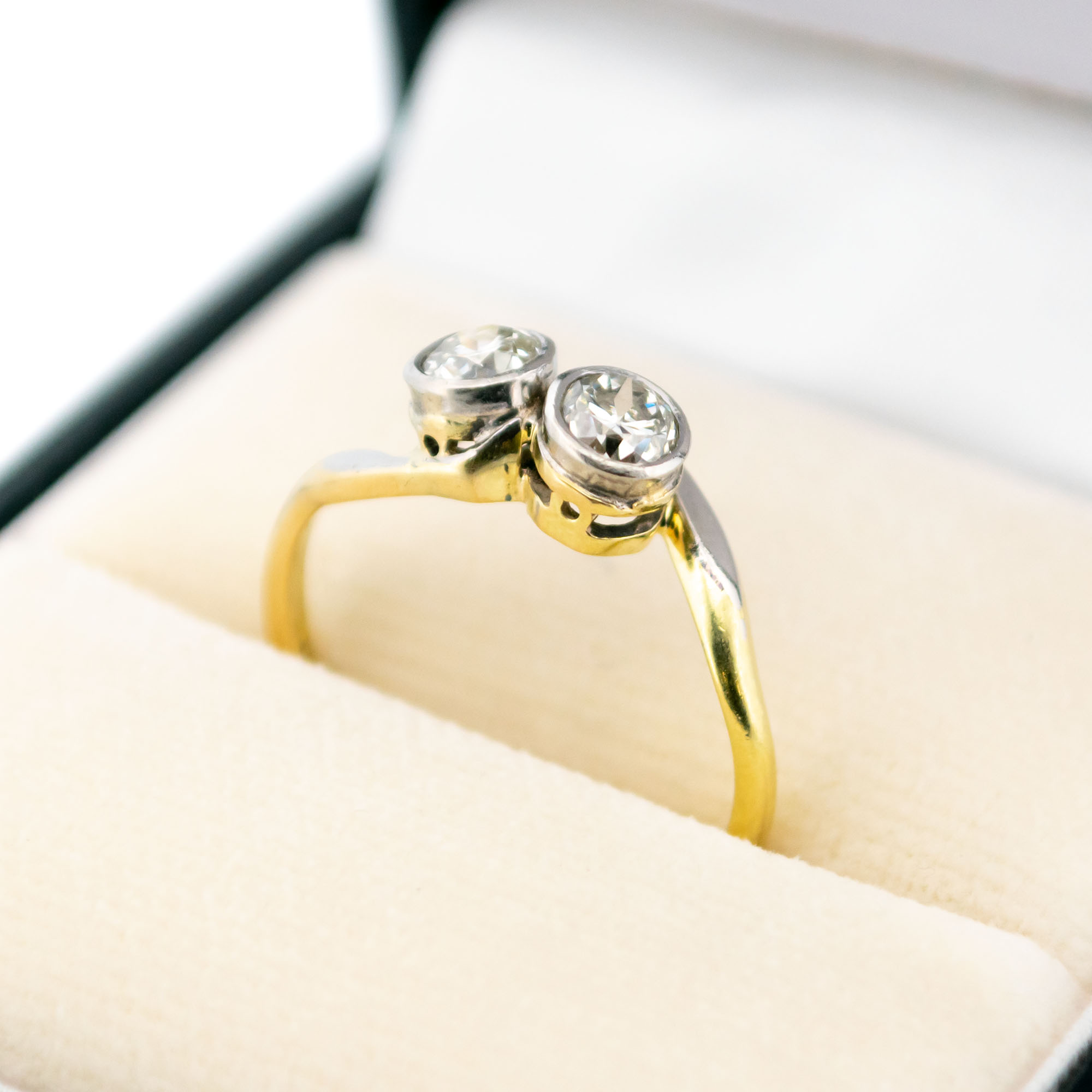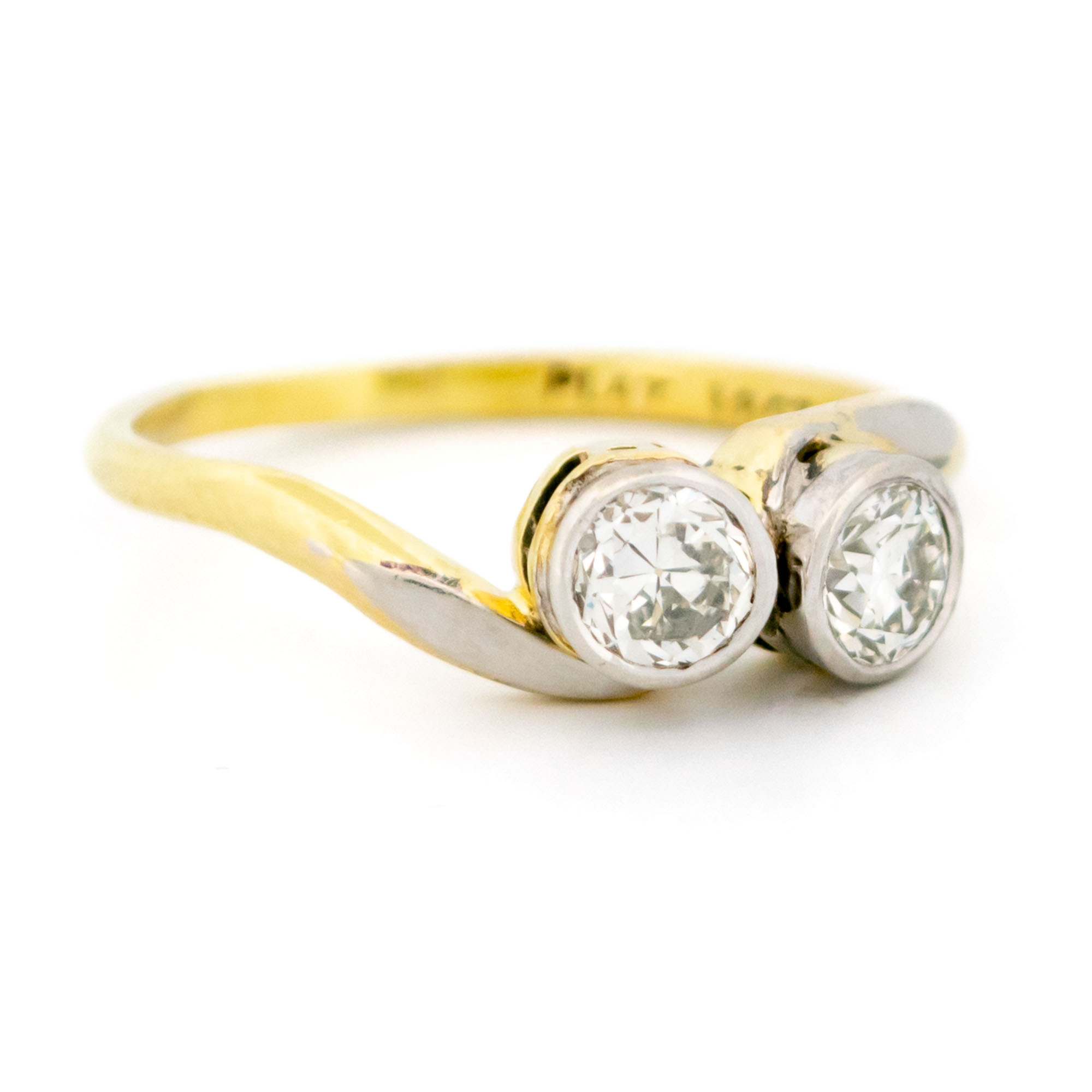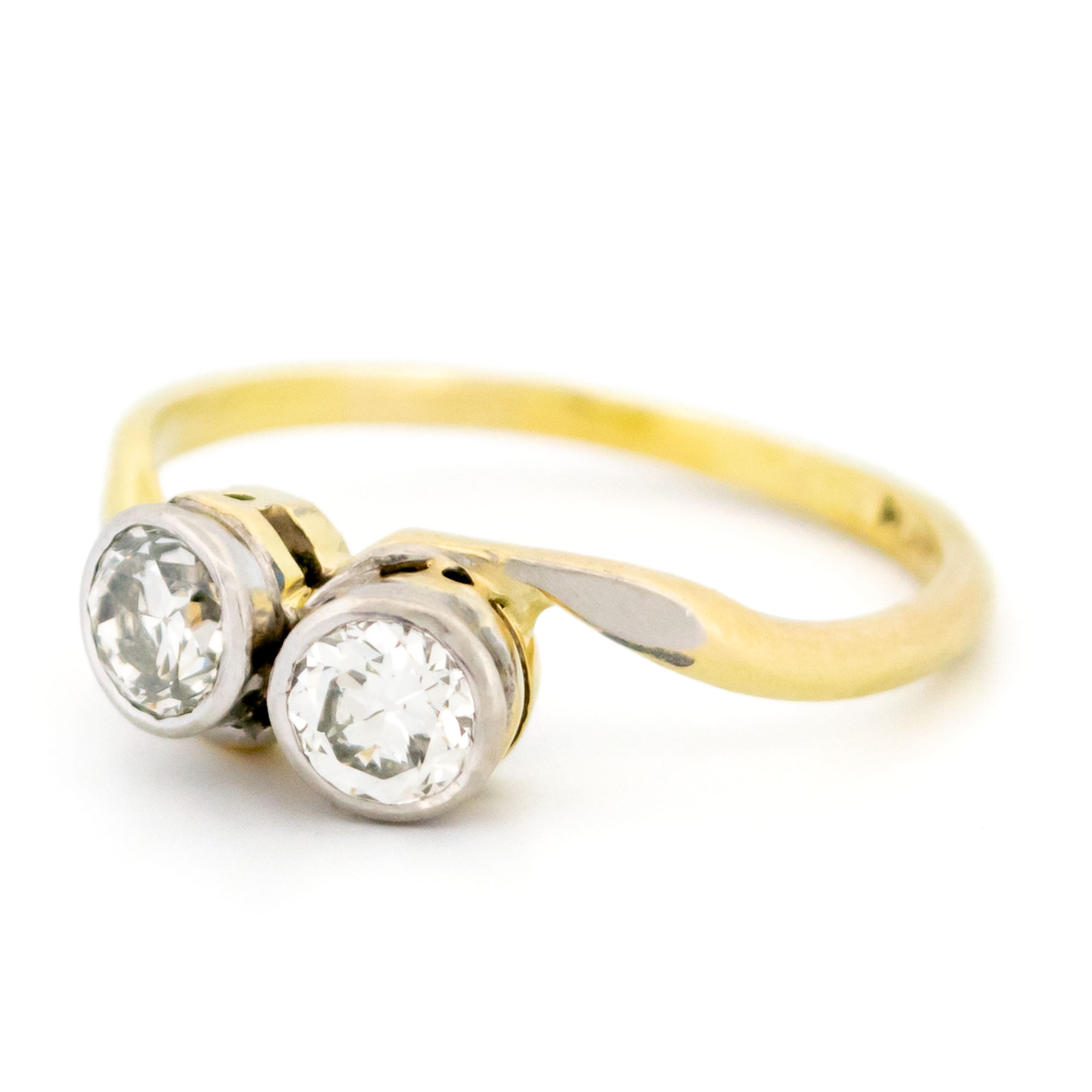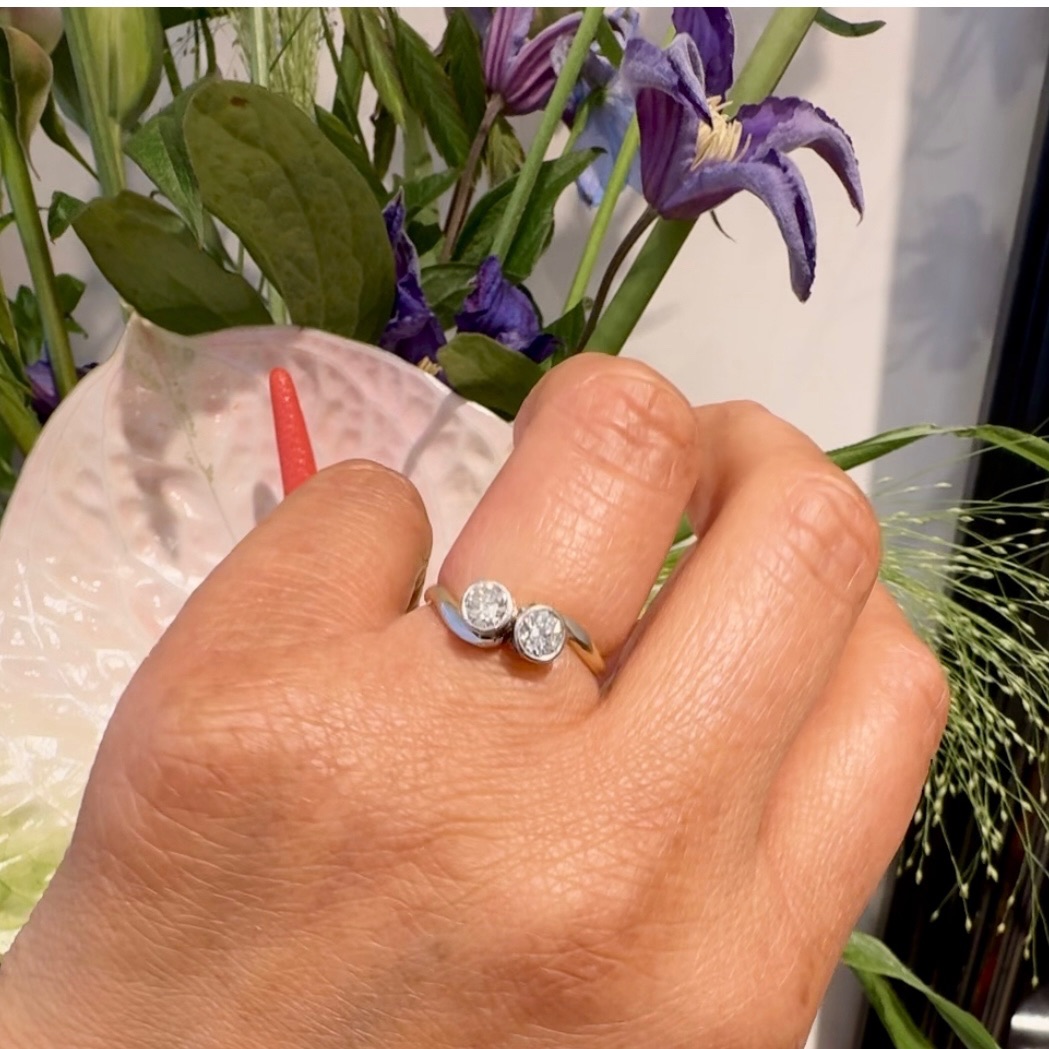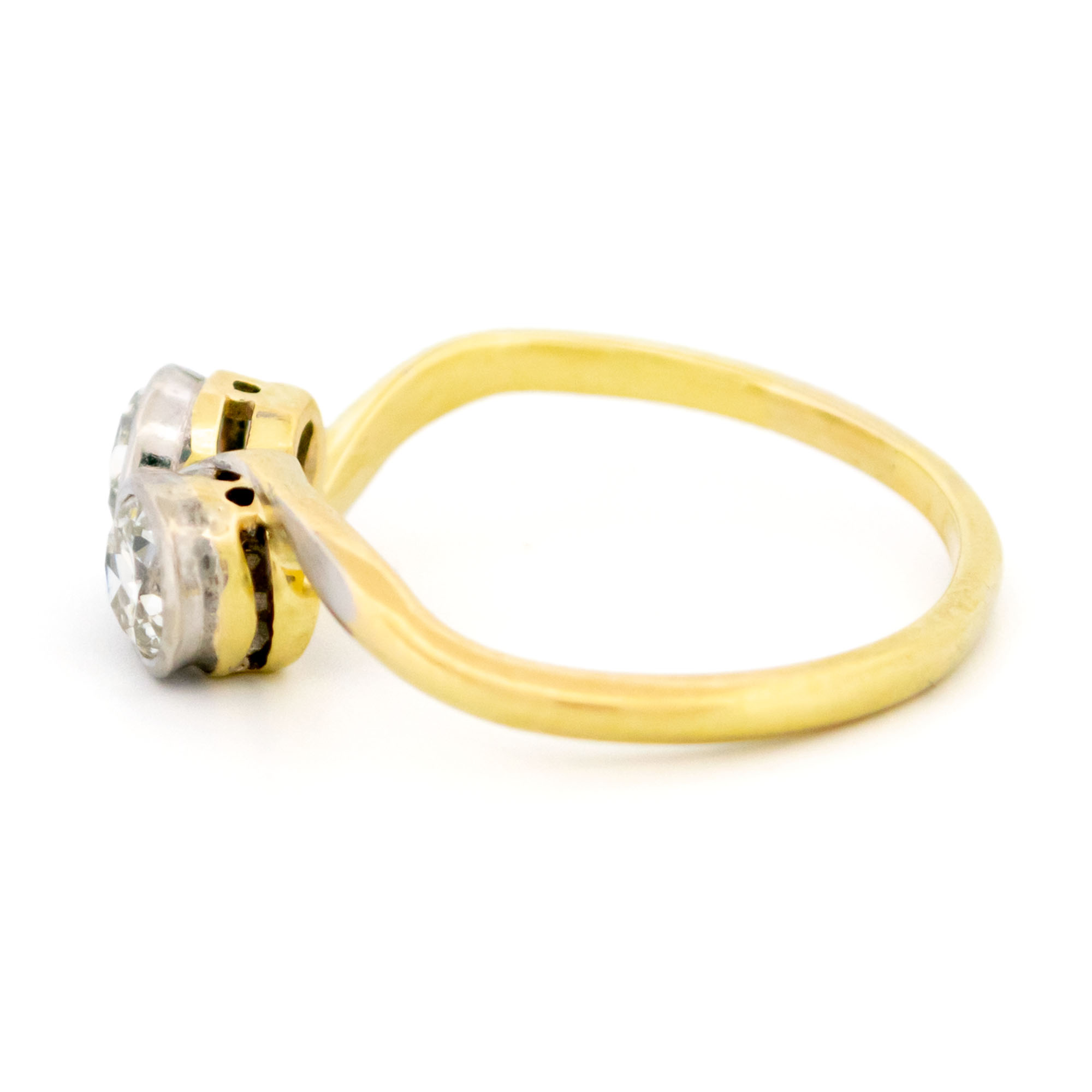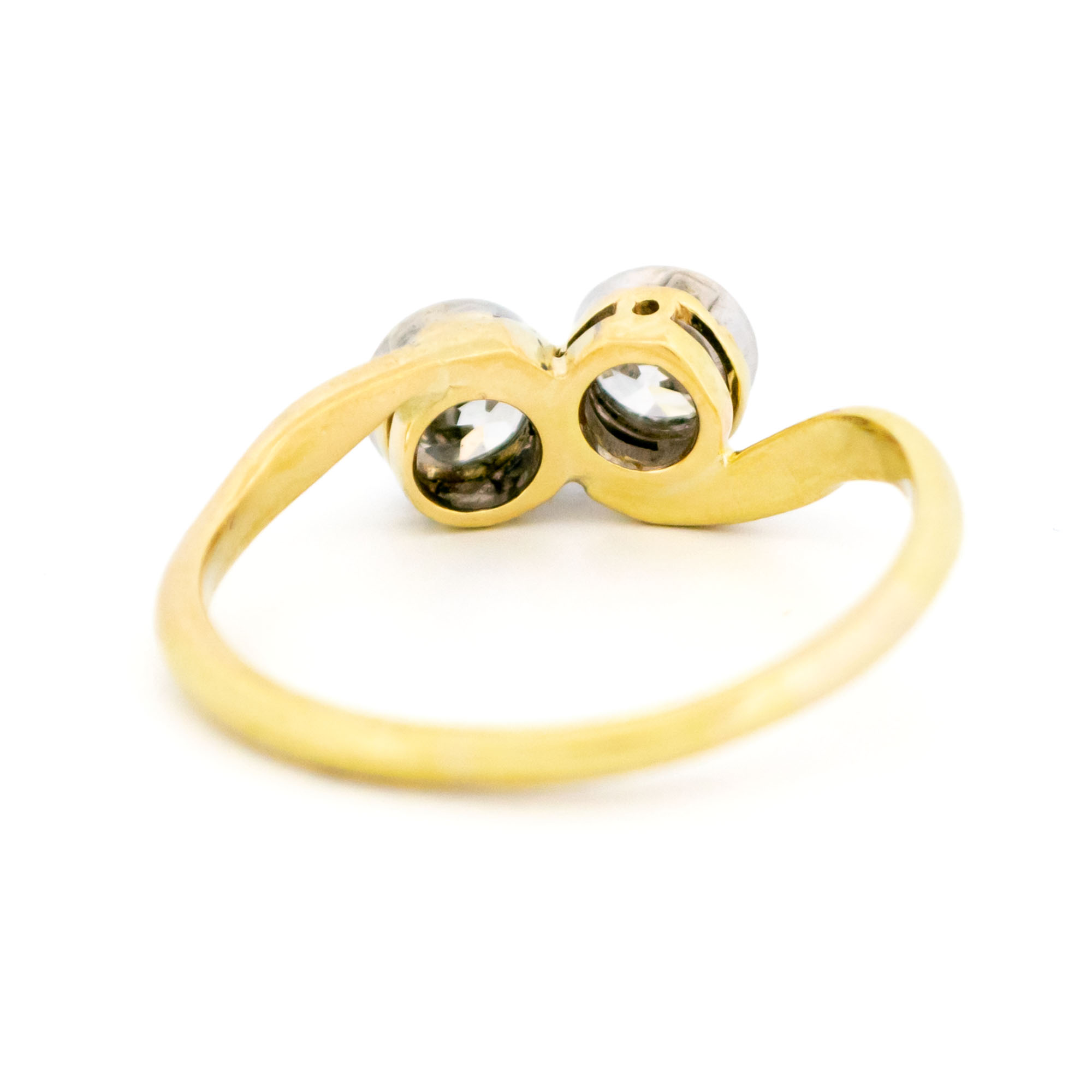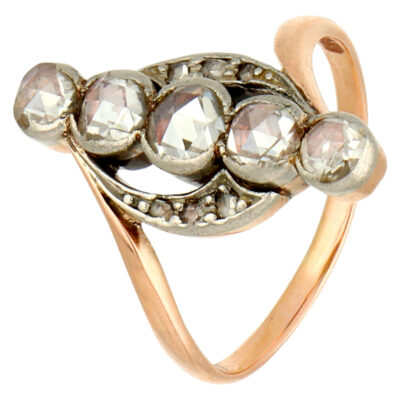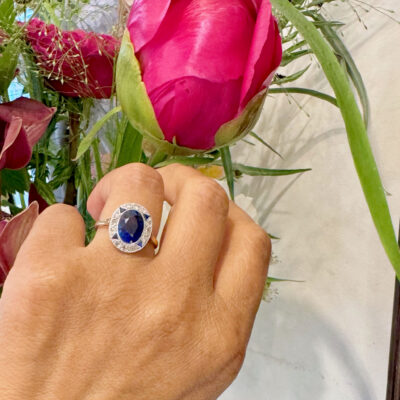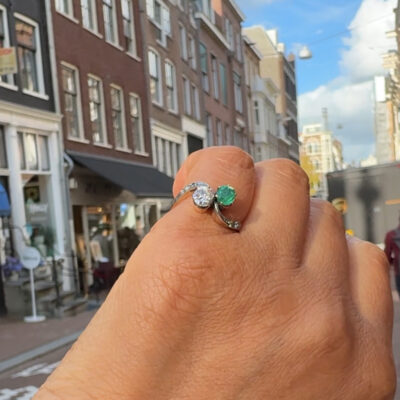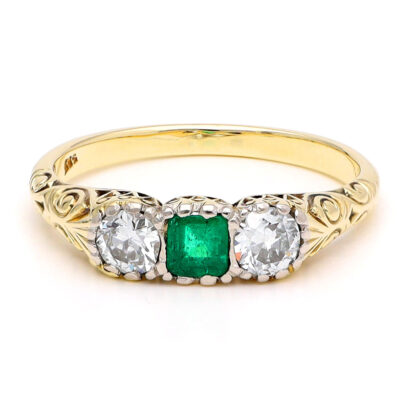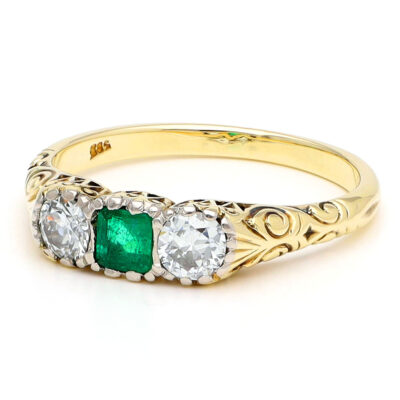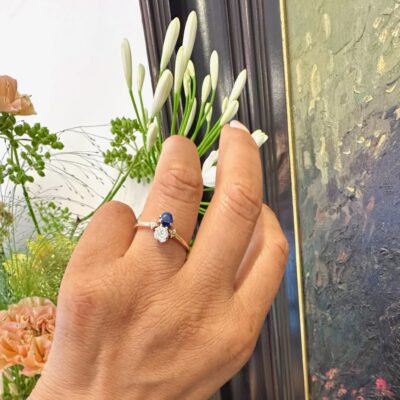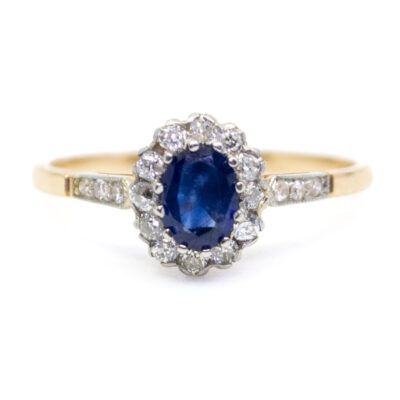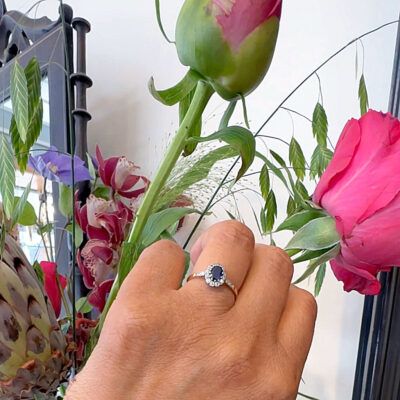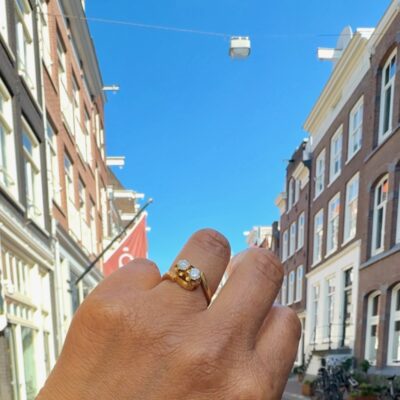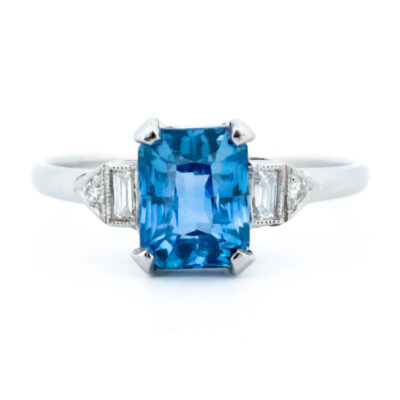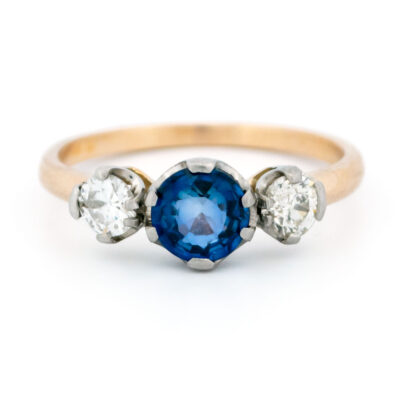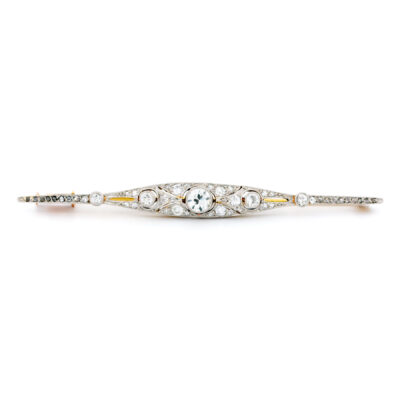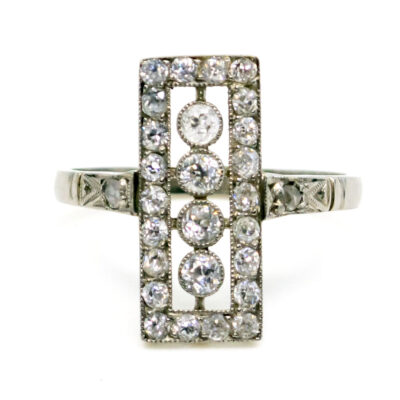A timeless symbol of love, this early 20th-century toi et moi ring (circa 1910–1940) beautifully unites two sparkling old European-cut diamonds in a graceful embrace. Set in sleek platinum bezels atop a warm 18k yellow gold band, the slightly offset diamonds create a romantic, flowing design. The gentle twist of metals enhances its symbolic connection—two souls intertwined. A sentimental and elegant heirloom, perfect for vintage jewelry lovers. 💞
Videos
Details: ±0.45ct (H SI1) Old-european-cut diamonds, 18k, Platinum Ring.
Design Era: Early 20th Century (1910-1940).
Size: 16.0 NL / 50.5 FR / 5½ US / K½ UK, sizeable (Within reason. Contact seller for information).
Weight in grams: 2.2.
Condition: Very good condition – slightly used with small signs of wear.
This is a charming early 20th century toi et moi ring (circa 1910–1940), beautifully crafted in 18k yellow gold and platinum. The “toi et moi” design, which translates to “you and me” in French, symbolizes two intertwined souls and is a timeless representation of love and connection.
Key Features:
Design and Style:
The toi et moi motif is formed by two adjacent bezel-set old European-cut diamonds, slightly offset for a flowing and romantic aesthetic.
The band features a gentle twist where the yellow gold and platinum meet, emphasizing the connection between the two diamonds. This combination of metals was popular in the early 20th century and enhances the ring’s elegance.
Diamonds:
The two diamonds are old European-cut, collectively weighing approximately 0.45 carats.
They are graded approximately H color and SI1 clarity, providing excellent brilliance and sparkle while retaining the character of antique cuts.
The diamonds are set in platinum bezels, which provide a sleek, polished contrast to the warm yellow gold band and enhance the diamonds’ white brilliance.
Metals:
The ring’s 18k yellow gold band provides a warm and classic foundation, typical of the Edwardian and early Art Deco periods.
Platinum accents in the diamond settings were used for durability and to highlight the diamonds’ beauty.
Historical Significance:
This ring reflects the elegance and romantic sentiment of early 20th-century jewelry, blending simplicity with symbolic meaning. Its delicate craftsmanship and timeless design make it an ideal choice for collectors of antique jewelry or as a unique engagement piece.
Shipping and Pickup: This delicate piece ships from our store located in the center of Amsterdam, The Netherlands. We offer both registered shipping and local pickup at our store. In the case of local pickup, any applicable shipping costs will be refunded.
About Us: Add some sparkle to your style with Binenbaum.com. We offer a stunning selection of antique and vintage jewelry that you won’t find anywhere else. From timeless rings and dazzling necklaces to unique brooches, we have something for every taste and occasion. Visit our website today and treat yourself to a piece of history.
| Design Era | |
|---|---|
| Design & Historical Context | During the 1910s to 1950s, the design of jewelry remained creative and stylish despite being impacted by economic and military events. Jewelry fashions during this time were influenced by various parts of the world, including the Near and Far East, and featured both exotic and geometric patterns that reflected the emergence of the machine age. New York became an important center for fashion along with Paris, and European jewelry companies had the opportunity to sell to and purchase from the Indian subcontinent. Art Deco jewelry, characterized by the use of numerous gemstones, was popular during this time, and the use of gold in jewelry increased in popularity due to its lower cost compared to platinum. Jewelry design also attracted artists and designers from various fields, giving hints about the direction that the industry would take in the future. |
| Key Materials | |
| Materials & Craftsmanship | Old-european-cut diamond: The Vintage Sparkle of Classic Romance Old European-cut diamonds are a beloved choice for those who appreciate vintage elegance and timeless beauty. This diamond cut, which was predominant from the late 19th century through the early 20th century, is known for its round shape, high crown, small table, and large, open culet. These characteristics give the stone a soft, romantic sparkle that evokes the charm of a bygone era. Historically, the Old European cut was the precursor to the modern round brilliant cut. It was crafted by hand, with each facet carefully shaped to maximize the diamond's brilliance under the softer lighting conditions of the time, such as candlelight. This cut was popular during the Victorian, Edwardian, and Art Deco periods, making it a favorite in antique and vintage jewelry. In modern jewelry, Old European-cut diamonds are highly sought after for their unique sparkle and historical significance. They often exhibit a warmer, more subdued brilliance compared to modern cuts, with an emphasis on depth and fire rather than the bright flashes of light seen in contemporary diamonds. This makes them ideal for engagement rings, earrings, and other pieces that celebrate vintage style and craftsmanship. An Old European-cut diamond is more than just a gemstone; it is a piece of history, reflecting the elegance and romance of the past. Its distinctive charm and enduring beauty make it a perfect choice for those who appreciate the artistry and nostalgia of vintage jewelry. 18k: The Perfect Balance of Luxury and Durability 18k gold is a luxurious and highly sought-after material in the world of fine jewelry, known for its rich color, durability, and value. The "18k" refers to the purity of the gold, indicating that it is composed of 75% pure gold and 25% alloyed metals, such as copper, silver, or palladium. This combination provides the perfect balance between the softness of pure gold and the strength needed for creating durable jewelry. Historically, gold has been prized for its beauty and rarity, symbolizing wealth, power, and status across various cultures and civilizations. 18k gold has been a preferred choice in fine jewelry for centuries due to its ideal blend of purity and strength, offering a radiant gold color that is more vibrant than lower karat golds while still being hard enough for everyday wear. In modern jewelry, 18k gold is favored for its versatility and its ability to enhance the appearance of gemstones. It is available in several colors, including yellow, white, and rose gold, depending on the metals used in the alloy. Each color has its unique appeal: Yellow Gold: The classic choice, offering a warm, rich hue that pairs beautifully with a wide range of gemstones and complements all skin tones. White Gold: A sleek, modern option that resembles platinum or silver but with the strength and luxury of gold. It is often rhodium-plated to enhance its reflective surface. Rose Gold: A romantic, pinkish hue that has gained popularity for its vintage charm and contemporary appeal, achieved by alloying gold with copper. 18k gold is commonly used in engagement rings, wedding bands, earrings, necklaces, and bracelets, where its balance of durability and beauty makes it ideal for both intricate designs and simple, elegant pieces. The alloy's added strength ensures that jewelry can withstand daily wear while maintaining its luster and shape. 18k gold is more than just a material; it is a symbol of refined taste and enduring value. Its perfect blend of luxury and practicality makes 18k gold a timeless choice for those who seek the beauty of high-purity gold without sacrificing durability. Whether in classic or modern designs, 18k gold jewelry offers a radiant and lasting expression of elegance and sophistication. Platinum: The Metal of Endurance and Prestige Platinum, a rare and precious metal, is renowned for its exceptional strength, purity, and enduring beauty. With its naturally white luster and remarkable resistance to tarnish and corrosion, platinum has become synonymous with luxury and durability in the world of fine jewelry. Historically, platinum has been valued for its rarity and unique properties. Ancient Egyptians and Pre-Columbian civilizations used platinum in their ceremonial jewelry, though its full potential wasn’t realized until the 18th century. By the 20th century, platinum became the metal of choice for royalty and high society, particularly in engagement rings and fine jewelry, due to its ability to securely hold precious gemstones. In modern jewelry, platinum is highly prized for its hypoallergenic properties and its ability to withstand daily wear without losing its brilliance. Its density and weight give it a luxurious feel, while its purity—often 95% pure—makes it an ideal setting for diamonds and other gemstones. Platinum's naturally white sheen enhances the sparkle of gems, and its durability ensures that jewelry pieces crafted in platinum can be passed down through generations. Platinum is more than just a metal; it is a symbol of strength, rarity, and timeless elegance. Its unmatched durability and sophisticated appearance make it the ultimate choice for those seeking jewelry that lasts a lifetime while maintaining its prestige and beauty. |
| Size | |
| Gender | |
| Weight (in grams) | 2.2 |
| Condition | Very good condition – slightly used with small signs of wear |
By following these tips, you can enjoy your precious jewelry for many years to come.
Related Products
-
Diamond 18k Row Ring 16733-8967
€ 5.895,00 VAT incl. (where applicable) -
Diamond 14k Platinum Crossover Ring 16249-8773
€ 1.995,00 VAT incl. (where applicable) -
Diamond Sapphire 18k Platinum Cluster Ring 16363-8820
€ 2.495,00 VAT incl. (where applicable) -
Diamond Emerald 18k 925′ Silver Toi Et Moi Ring 15903-2463
€ 2.696,00 VAT incl. (where applicable) -
Diamond Emerald 14k Row Ring 17887-9322
€ 2.495,00 VAT incl. (where applicable) -
Diamond Sapphire 14k Toi Et Moi Ring 17521-9224
€ 1.695,00 VAT incl. (where applicable) -
Diamond Sapphire 14k Platinum Cluster Ring 17315-4977
€ 1.895,00 VAT incl. (where applicable) -
Diamond 18k Toi Et Moi Ring 17047-9089
€ 2.695,00 VAT incl. (where applicable)
- Home
- Collection
- Fine Jewelry
- Silver Jewelry
- Silverware
- Boxes
- Candlesticks
- Salt and pepper shakers
- Miniatures
- Salt cellars
- Spoon Set
- Condiments
- Frames
- Napkin Ring
- Spoon
- Oddities
- Cups
- Vases
- Cutlery
- Serving Spoon And Cake Server
- Candlesticks
- Baskets
- Hanukkiah
- Spice Tower
- Yad
- Tea Set
- Sugar Castor
- Napkin Rings
- Wine Bottle Coaster
- Wine Stopper
- Tea Pot
- Jugs
- Rattles
- Hip Flask
- Miscellaneous
- Rings 💍
- About
- Contact
- No products in the cart.
